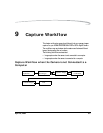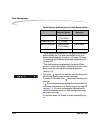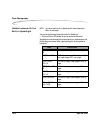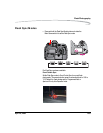
10-2 April 29, 2004
Flash Photography
D-TTL Flash Control The type of D-TTL flash control varies with the type of lens in use:
Lens Flash control for built-in Speedlight
Type G or
D CPU lens
3D Multi-Sensor Balanced Fill-Flash for Digital SLR:
Based on information from the matrix metering system, flash
output is adjusted to provide balance between the main
subject and ambient background lighting. The Speedlight
emits a series of nearly invisible pre-flashes (monitor
pre-flashes) immediately before the main flash. Pre-flashes
reflected from objects in all areas of the frame are picked up
by the camera’s through-the-lens (TTL) multi-sensor and
analyzed in combination with data on the current sensitivity
(ISO equivalency) setting, aperture, lens focal length,
exposure compensation, and distance information provided
by the lens. The results of this analysis are used to balance
flash output with natural light. 3D multi-sensor balanced
fill-flash for digital SLR is not available in Manual Exposure
mode or when you use Spot Metering.
Other CPU
lens
Multi-Sensor Balanced Fill-Flash for Digital SLR: As
above, except that distance information is not included in
regulating flash output. Not available in Manual Exposure
mode or when you use Spot Metering.
All types Standard TTL Flash for Digital SLR: Flash output is
adjusted to ensure that the main subject is correctly exposed,
without taking the background into account. It is
recommended for shots in which the main subject is
emphasized at the expense of background details, or when
exposure compensation is used. Standard TTL flash for
digital SLR is activated automatically when:
• Built-in Speedlight: the function dial is set to M
(Manual Exposure mode) or Spot Metering is selected
• Optional Speedlight: Spot Metering is selected


















